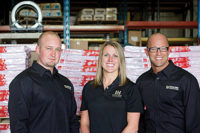To most, the idea of chasing storms doesn’t exactly sound appealing. It can be dangerous, time consuming and become both a physical and mental drain on your overall roofing business. But it can be lucrative: the value of insured losses due to thunderstorms and hail events in the United States averaged $11.5 billion over the past 10 years.
The 2016 storm season is upon us and to roofing contractors that specialize in the area of storm restoration, it’s business as usual. Most storms move quickly, making the timeline for action a small one. In this area of roofing, it’s important to know what you’re supposed to do and when.
Speaking with stressed out homeowners while trying to educate them on their best options moving forward can be difficult, so it’s imperative to understand the best approaches when consulting potential customers. David Johnson, director of national accounts at ABC Supply Co. Inc., recently shed some light on the process of storm restoration, as well as some helpful tips for those already involved, or perhaps wanting to get involved in this competitive market.
Q: What is the first step roofing contractors should take following a storm?
A: As a roofing contractor, your first job immediately after a storm is to assign sales teams to promptly get out into the community to put your company name out to affected residents and businesses. Start by distributing as many door hangers as possible, which should direct homeowners to either a professional, informative website or other social media tools that have pertinent information and recommend key actions to take.
The team representing your company should be professional and dressed in apparel with your logo. Additionally, prepare them to speak to the quality of your company, including the number of years in business. All employees should also be ready to discuss the restoration process and timing expectations with prospective customers.
Q: What different products and tools are available for contractors to help with “predicting” the weather?
A: Contractors should stay informed during their region’s peak storm seasons by paying close attention to news broadcasts and utilizing real-time weather apps, which are often available for free.
Q: Emotions can run high for customers whose homes or businesses are damaged by storms. What are best practices for approaching potential customers during difficult times like these as well as educating customers on their needs?
A: Contractors can get ahead of the stress that storms cause by being active participants in the surrounding community well before storms hit. This establishes brand trust and respect among your community and customers, which will ultimately keep you top of mind when a storm event occurs.
Emphasize your businesses’ core values and ethical standards, which can be augmented by past customer references. This is your company’s opportunity to educate homeowners on what to look for in a quality contractor. You can further strengthen your image by being out in the community immediately after storms with tarps, bottles of water and other essentials to offer homeowners with immediate needs. Be honest and be humble, but most importantly, let them know you’re in the business of helping people restore their lives after these hard situations.
Q: What are the biggest obstacles in the storm restoration business and how can businesses overcome them?
A: One thing you can do to improve as a contractor is to ensure that you’re able to take on jobs that have unknowns in terms of timing and scope. A great way to help with this is to be as ready as possible for any kind of job that may arise so that you’re in the best position possible for successful execution.
Start by preparing your crew by way of safety training, situational questions and job response practice. In addition, check if you have all the correct equipment that different jobs might require and order any supplies or materials you need as soon as possible. You don’t want any last-minute surprises that could have been avoided.
Q: What steps should be taken through each storm encounter to ensure improvement?
A: As a contractor, try to learn from each storm job so you can apply that learning to the next job. ABC Supply always recommends scheduling ample review and feedback rounds after a storm job to allow crews to voice any concerns or questions they had during the (often chaotic) storm.
You can also provide the opportunity for feedback in the form of a questionnaire or by meeting with individual members of your crews. From there, you can create a checklist or project plan to ensure these issues are addressed and any necessary changes are implemented during the next job. Furthermore, take advantage of this time by assessing the condition of your equipment and any repairs and upgrades you might need.
Q: What are some tips for contractors that specialize in storm restoration?
A: Often contractors get behind in rapid storm response if they don’t have the right inventory and supplies. Establishing collaborative relationships with area distributors in advance helps when the time comes to start work. Once a storm hits, you’ll know who to call and where to go, ensuring that you’re ahead of other contractors.
Q: How has storm restoration changed or developed over the last decade?
A: The scrutiny of contractors working storm events has increased dramatically in recent years, making it more important than ever for roofing contractors to demonstrate transparency and good business practices. It’s also extremely important to know the latest solicitation rules and state and local licensing requirements.
In terms of new innovations, technology plays a huge part in the industry and its elevated response timing and managing tactics.
Q: Are there preparations that go into play before the storm hits? Is there any education and/or training that you recommend relating to storm restoration?
A: The best way for contractors to get ahead of storms is to spend time creating a detailed timeline with their team before each project kicks off. This timeline should include items like milestone deadlines, contingency plans, safety training and identifying any potential hazards. As examples, milestone deadlines might be when your folks are on the ground actively canvassing after storms hit; a meeting with your team to establish a marketing plan with materials; a meeting with your crews to set project expectations; a scheduled meeting with your local branch manager to establish expectations (wants, needs, suitable credit line); or the goal by which you build your first job after a storm ends.
Contingency plans could be taking stock of extra inventory in case of any delay in product delivery or identifying backup team members to fill in if someone gets sick or injured.
For the restoration phase, be prepared to deploy a team into affected communities as quickly as possible after a storm hits. This helps get your company name and information out and assist with any immediate needs residents or businesses might have.
Compiled by Courtney Dobson, Associate Editor of Roofing Contractor. She can be reached at 248-786-1233 or dobsonc@bnpmedia.com.







Report Abusive Comment